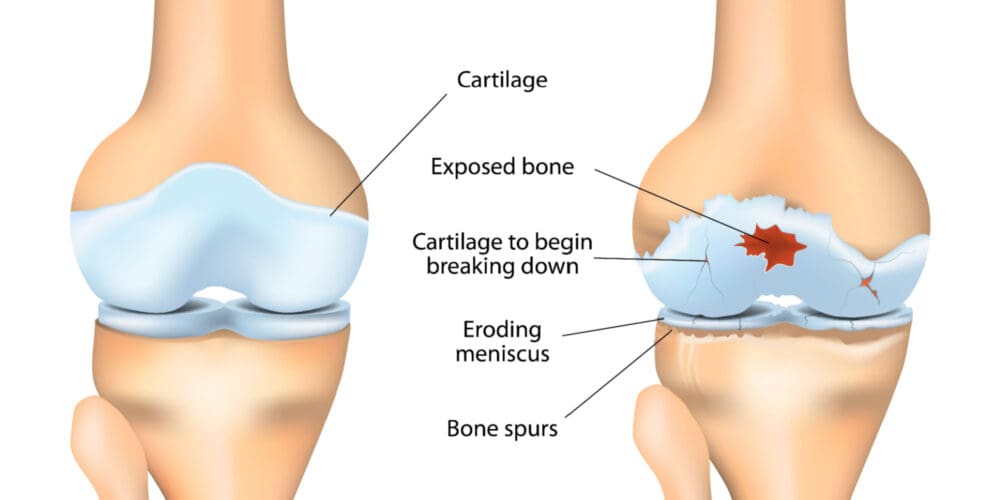Knee osteoarthritis is a chronic, progressive condition affecting 32.5 million people in the United States alone. And while there are several remedies to alleviate pain, one popular treatment may actually be worsening the disease, according to two new studies published earlier this week.
Let’s explore what knee osteoarthritis is, what the studies found, and alternative ways to treat your chronic pain.
What Is Knee Osteoarthritis?
Osteoarthritis of the knee, also referred to as degenerative joint disease of the knee, is the most common form of arthritis. It’s typically the result of wear and tear and the progressive loss of articular cartilage, i.e., the smooth, white tissue that covers the ends of bones where they come together to form joints. When this cartilage in the knee breaks down, bone starts to rub against each other, causing the knee to hurt, stiffen, and even swell.
Knee osteoarthritis can be divided into two categories: primary and secondary. Primary osteoarthritis is atrophy of cartilage without any underlying health reason; secondary osteoarthritis is the result of abnormal force or trauma across the knee or abnormal articular cartilage, such as rheumatoid arthritis.
Moreover, this condition is typically a progressive disease that worsens over time and may eventually lead to disability, although the intensity of pain may vary from person to person. And while several treatment options make managing symptoms possible such as physical therapy and anti-inflammatory drugs, one popular treatment may actually exacerbate knee osteoarthritis pain and further progress the disease.
What the Studies Found
Presented at the annual meeting of Radiological Society of North America (RSNA) were the results of two studies that compared injections commonly used to relieve pain from knee osteoarthritis. The studies found that corticosteroid injections, a type of steroid that lowers inflammation in the body, were associated with the progression of the disease.
“Knee osteoarthritis is a chronic, degenerative and progressive condition with an estimated incidence of 800,000 patients each year,” says Upasana Upadhyay Bharadwaj, M.D., a lead author of one of the studies. “More than 10% of patients with knee osteoarthritis seek noninvasive treatment for pain relief through corticosteroid injections.”
In the first study, MRI imaging was used to track the progression of osteoarthritis in the knees of patients over a two year period; the second used radiography or X-ray. Both studies showed a significant increase in progression of degenerative changes in knee cartilage in patients that had corticosteroid injections compared with those who had hyaluronic acid or no injections, highlighting the need for caution when administering corticosteroids for osteoarthritis pain.
“While both corticosteroid and hyaluronic acid injections are reported to help with symptomatic pain relief for knee osteoarthritis, our results conclusively show that corticosteroids are associated with significant progression of knee osteoarthritis up to two years post-injection and must be administered with caution,” Dr. Upadhyay Bharadwaj said. “Hyaluronic acid, on the other hand, may slow down the progression of knee osteoarthritis and alleviate long-term effects while offering symptomatic relief.”
Alternative Treatments for Knee Osteoarthritis Pain


While there is no cure for knee osteoarthritis, there are treatments that can slow the progression of the disease and relieve discomfort. And unlike corticosteroid injections, they won’t worsen your symptoms over time.
The following treatment options will depend on your individual needs, such as your medical history, severity of pain, and the impact osteoarthritis has on your daily tasks. Be sure to talk with your primary care physician before starting a new treatment.
1. Regular exercise
This one may feel counterintuitive, but exercise is a great way to reduce joint pain, strengthen flexibility, and can even combat fatigue. But don’t worry, you don’t have to do anything extreme to relieve knee osteoarthritis; low-impact activities like cycling, swimming, and walking are sufficient exercises to strengthen the muscles around the knee and stabilize it. Consider working with a physical therapist to help you stick to an exercise routine and ensure you’re exercising safely.
2. Maintain a healthy weight
Body weight accelerates joint degeneration, meaning the heavier you are, the greater the stress is on your joints and the more susceptible your knee is to osteoarthritis.
The knees alongside the hips bear the brunt of your body weight. Every time you take a step, the force that occurs when your foot hits the ground travels up your legs, and as your joints absorb the impact, it contributes to the ongoing wear and tear that causes osteoarthritis.
If you’re currently overweight losing a few pounds can help alleviate osteoarthritis symptoms and may even help reduce inflammation and other health risks such as type 2 diabetes and cardiovascular disease.
3. Medications
Medications that can help relieve knee osteoarthritis symptoms include:
- Nonsteroidal anti-inflammatory drugs (NSAIDs): Over-the-counter pain NSAIDs like Advil, Motrin, and Aleve are effective at relieving pain but anything stronger usually requires a prescription. Additionally, be mindful of your consumption and take at the recommended dose as NSAIDs can cause an upset stomach, cardiovascular issues, and liver and kidney damage.
- Acetaminophen: Acetaminophen like Tylenol have also been shown to relieve osteoarthritis pain but taking more than the recommended dose can cause liver damage.
- Duloxetine (Cymbalta): Duloxetine is normally used as an antidepressant but it’s also been approved to treat chronic pain.
4. Therapies
Alongside exercise, weight management, and medications, alternative therapies may reduce knee osteoarthritis pain. Safe and effective therapies recommended by the American College of Rheumatology and the Arthritis Foundation (ACR/AF) include:
- Heat and cold packs
- Acupuncture
- Occupational therapy to teach new ways to live with chronic pain
- Stress management activities such as meditation or yoga
- Cognitive behavioral therapy to manage pain and stress
5. Surgery (for extreme cases)
Sometimes osteoarthritis pain can be so severe that the above treatment methods are no longer effective at relieving pain. When this happens, surgery may be recommended by your doctor.
From minimally invasive procedures to a total knee replacement, there are various surgical options for osteoarthritis of the knee. These include arthroscopic surgery, where a camera views the inside of the knee and joint tissue is repaired; osteotomy, where a surgeon will cut and reshape bone, taking pressure off the injured area; and replacement of the knee joint with an artificial joint.
Have You Been Impacted by Knee Osteoarthritis?
Let us know in the comments below!
What Topics Should We Cover Next?
Email us your ideas at info@painresource.com
Join the Pain Resource Community
Did you know Pain Resource has different groups for different conditions? Connect with others who share the same condition as you here.






Gotta love when the stuff that’s meant to help you makes things even worse. :(